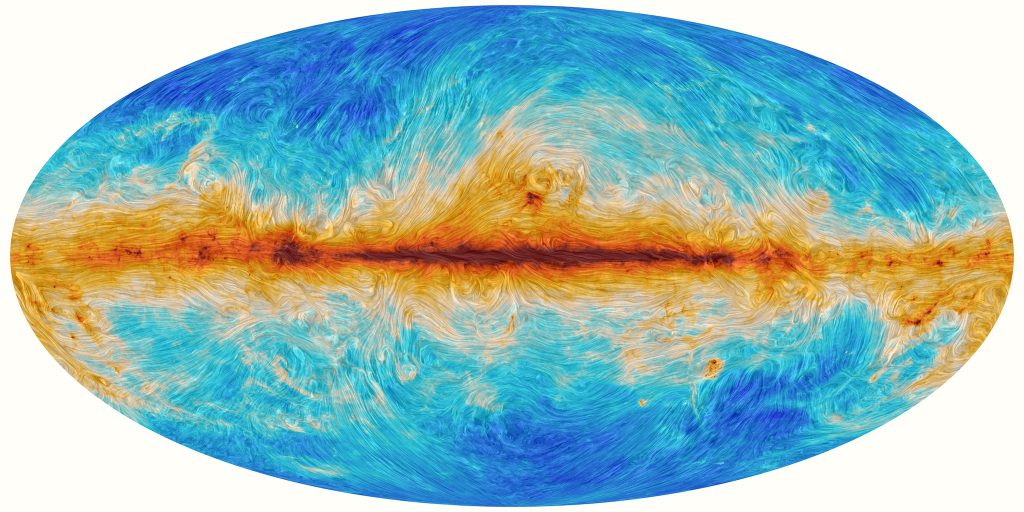COSMOLOGY – late Universe
In the quest towards measuring the pristine Cosmic Microwave Background it is essential to have a good understanding of the astrophysical effects which can influence the photons as they travel through the universe. Due to the CMB being the backlight of our entire universe, everything in our Hubble volume has an influence on the light we want to measure. Thankfully we can pin down the main effects.
Weak gravitation lensing
One major effect is the distortion of light intensity and polarization by weak gravitational lensing along the whole line of sight, between last scattering surface and observation. According to Einstein’s theory of gravitation, all the matter in the universe bends space-time and therefore alters the geodesics of the photons of the CMB. In practice it turns out that this effect can be modelled to a very good precision by assuming a single lens on the line of sight, which deflects the light according to the integrated gravitational potential along this line. However, this is not only contaminating the primordial signal, but also allows to indirectly measure the distribution of matter in the universe and therefore opens up new possible science with then CMB, such as neutrino and dark energy physics. Since the main contribution to the lensing comes from relatively late times, when matter becomes homogeneous and clustered enough, the effect on the scale dependent power spectrum becomes important at smaller scales. A very sensitive measurement of these scales can eventually allow to mitigate this effect as a bias and an extra variance in the power spectrum of CMB B-modes.
Copyright ESA and the Planck Collaboration
Emission and scattering of distant Galaxies
But the matter in the universe causes not only a distortion due to lensing. Single compact, point-like sources – meaning galaxy clusters, galaxies and stars in the milky-way in the language of a cosmologist – can contaminate the CMB measurement. They can radiate light such that the redshift effect due to the expanding universe transforms it into microwave light which can be confused for the CMB. They also can distort the spectrum of the CMB via the thermal Sunyaev-Zel’dovich effect, which causes a change in temperature of CMB photons due to inverse Compton scattering off of hot electrons in the intracluster medium of galaxy clusters.
Microwave emission of our Galaxy

Another – and very tedious – contaminant of the measured CMB comes from our own galaxy, the milky-way. Being visible in a clear night sky by eye, it also radiates at frequencies we want to measure the CMB in. And since the CMB signal we are after is so faint, it is impossible to avoid it by measuring a patch on the sky which appears clear. We can identify two major components which outshine the CMB. One being clouds of dust in the interstellar medium consisting of tiny particles smaller than 1 μm made mainly out of sand and soot emitting light with a modified black-body spectrum. Moreover, these particles can align with the galactic magnetic field causing linear polarized light. Furthermore, relativistic electrons of the interstellar medium, accelerated by a magnetic field, can produce synchrotron radiation, with a spectrum depending on both the intensity of the magnetic field and energy of the electrons. These are the two effect which are known to contaminate CMB polarization spectra and a precise knowledge of them is necessary to obtain a final spectrum of the polarized CMB, especially at large angular scales. In principle, given the knowledge of the different spectral behavior of these effects and the CMB and observations in multiple frequency bands, it is possible to disentangle these components.

